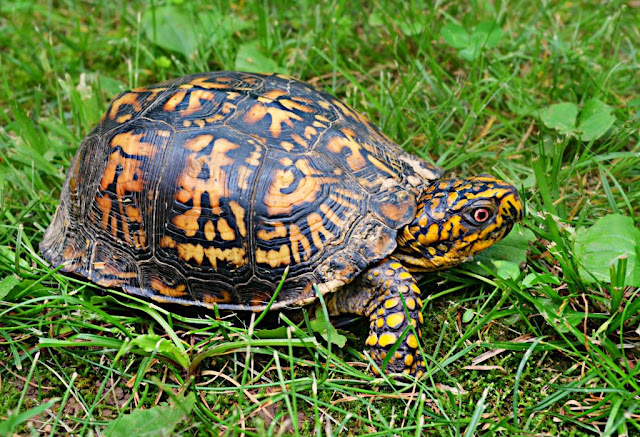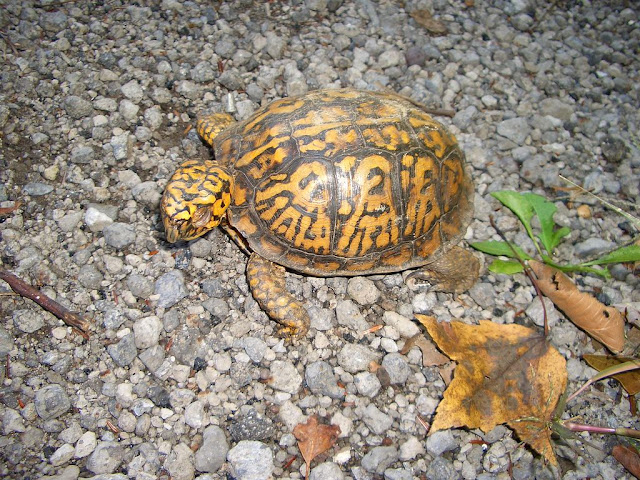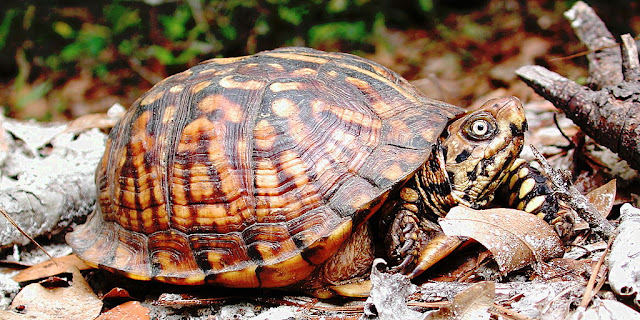Eastern box turtles are one of the most commonly seen
turtles in the wild. The reptile’s carapace is dome-shaped and covers most of
its body, and has ridges and furrows that develop with age. The upper part of
the turtle’s mouth is slightly hooked, and its toes are slightly webbed. On
average, an eastern box turtle is about five to six inches (13 to 15
centimeters) long.
There are several subspecies of eastern box turtles that
have different coloration. Some eastern box turtles have brown shells, while
others have olive-brown shells with decorative yellow markings. Most eastern
box turtles have yellow markings on dark feet and faces—however, some
individuals have no yellow markings at all.
Appearance
The eastern box turtle is a small reptile, reaching only
about six inches in length and weighing less than one pound. Its tall upper
shell, or carapace, is said to resemble a box. The carapace is brown with
variable patterns of orange and yellow markings. Its hinged lower shell, or
plastron, allows the turtle to hide its entire body, completely protected by
the shell. The plastron is usually dark brown, rarely with distinct markings.
The turtle has dark, scaly skin with yellow markings. Eastern box turtles have
hooked upper jaws, and their toes are only slightly webbed. Males have red
eyes, while females have yellow-brown eyes. Males are also larger than females.
Behavior
Turtles will forage over an area the equivalent of two
football fields over their lives. Adult individuals occupy "home
ranges" of variable sizes (larger in less favorable habitats or in systems
with relatively low population densities, smaller in more favorable or more
densely populated habitats). Immature individuals (less than nine years of age)
and many mature, but un-established males move extensively about as
"transients." The directionality of their movements is, apparently,
"one way," and quite energetically directional! (So, if you rescue a
box turtle crossing a road ALWAYS put it over on the side to which it was
heading!).
Box turtles are often found near to each other and can form
range-overlapping, socially tolerant groups of three or four individuals.
Fighting and other types of aggressive behavior are rare with the exception of
occasional "sparring" matches (especially between competing males)
that involve alternative bouts of two individuals biting each other's shells
with, obviously, little damage to either individual. Eastern box turtles walk
with a steady, energetic stride holding their heads upright. They can travel 50
yards or more in a single day and posess strong homing instincts that compel
them to move in the direction of their home ranges.
Habitat
Eastern box turtles prefer deciduous forests and mixed
forests. (A deciduous forest have trees and shrubs that shed their leaves
seasonally, while a mixed forest have evergreen trees as well, such as
evergreen firs and pine trees.)
The eastern box turtle is known to appreciate a moderately
moist forest floor with good drainage. Bottomland forest seems to be more
popular than ridges and hillsides.
Sometimes eastern box turtles are encountered in
non-forested areas, such as grasslands and pastures. Just as in the forests,
the turtles want the floor to be moderately moist in these environments and
seek out areas with wet leaves or wet dirt.
When the weather is warm, eastern box turtles cool off by
bathing in puddles and shallow streams. They can also submerge themselves in
mud, sometimes for days at a time, to avoid the heat.
Feeding
Box turtles are considered omnivorous, because their diet
consists of a wide variety of food items. Flowers, roots, fungi, berries,
snails, slugs, insects, fish, frogs, salamanders, snakes, and eggs are all
possible meals for box turtles. Young turtles are carnivores, but after they
reach the age of five or six years, they become primarily herbivores.
Diet
Eastern box turtles are predominantly carnivorous during
their younger years and become more and more herbivorous as they age. Prey
items taken by box turtles include, snails, worms, insects, spiders, frogs,
snakes lizards, small mammals, and carrion. They also eat fruits, berries,
leaves and many types of mushrooms. Some of the mushrooms consumed by box
turtles are very toxic for humans, so it is inferred that the turtles are
unaffected by these potential poisons. Humans eating box turtles that have
recently fed on poisonous mushrooms may become quite ill due to the toxins
accumulated in the turtles' flesh.
Reproduction
Eastern box turtles mature slowly, reaching sexual maturity
between 7 and 10 years of age. Once mature, a female box turtle will lay
between 3 and 6 eggs each spring in a shallow nest which hatch in late summer
or early fall. Hatchling box turtles measure only 1.25 inches (3 cm) in length.
Life History
Females lay their eggs in late spring–early summer. They can
be fertile up to four years after mating. Between two–seven eggs hatch after
12–13 weeks under normal climate conditions. The hatchlings are relatively
mobile from birth.
Housing
Eastern box turtles should ideally be kept outdoors, but a
large indoor inclosure will also work if you make sure that the turtle get
enough sun light or artificial UVA and UVB light. Full spectrum light is
required for vitamin D3 production.
The box turtle should be given opportunity to adjust its own
body temperature by moving to different parts of its enclosure. A sunny area
with a temperature of 85-87° F (29-30° C) should be combined with a cooler
shaded area where the temperature is in the 75-78° (24-26° C) range. The cooler
area should preferably have a moist substrate deep enough for the turtle to
burrow in. A water dish large enough for soaking should also be present in the
enclosure.
Sand, compost soil, smooth river gravel, moss and leaf
litter are all examples of suitable substrates. Try to mimic a natural
environment, e.g. by combining compost soil with some leaf litter and moss. The
eastern box turtle likes a moist substrate resembling a humid forest floor or
grassy meadow.
Thanks and If You Like,Please Share with Your FriendSs..




















No comments:
Post a Comment